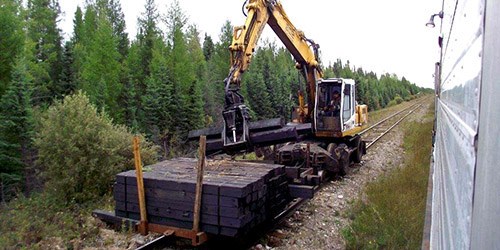The Huron Central Railway’s parent company is asking for a new infusion of public funds to pour into track maintenance to continue freight operations between Sault Ste. Marie and Sudbury.
In an emailed reply to Northern Ontario Business, Louis Gravel, president of Montreal-headquartered Genesee & Wyoming Canada, stopped short of saying rail service is in jeopardy, but answered the short-line railroader needs between $5 million and $6 million each year “in order to sustain the infrastructure.”
The Huron Central will be making its case before Sault Ste. Marie city council tonight, claiming in its prepared presentation that it’s in “survival mode.”
Gravel responded that freight volumes along the 278-kilometre line are “sufficient to cover the operating costs, but not the capital investment.”
He placed no timeline on when funds need to be in place, saying only discussions continue with various stakeholders to find satisfactory solutions to all the parties from an “economic and safety standpoint.”
The 44-employee railroad, which is headquartered in Sault Ste. Marie, hauls freight for Essar Steel Algoma in the Sault, the Domtar pulp and paper mill in Espanola, and the EACOM sawmill in Nairn Centre.
Those three companies account for 88 per cent of the line’s traffic with some 12,000 carloads annually.
The Sault-to-Sudbury track is owned by CP Rail. Genesee & Wyoming Canada is contracted to feed freight to the CP main line at Sudbury through its Huron Central subsidiary.
The company’s presentation to Sault council includes letters of support from Essar, Domtar and EACOM.
Back in 2009, the region came perilously close to losing the railway when the Huron Central threatened to drop service due to the track’s general state of disrepair and declining tonnage, mainly from Essar Steel.
The loss of service would have been devastating to those industry shippers on the line with no other economical way to move freight.
It could have put hundreds of steel-laden transport trucks on the road and threatened the future of the Espanola mill.
The City of Sault Ste. Marie, Ottawa and Queen’s Park scrambled to come up with $33 million which went into track bed improvements with new ballast and crossties, rail replacement and bridge upgrades.
But that staggered funding pool finally dried up in 2015.
Gravel said he’s been raising the tracking funding issue through “many meetings at every level (of government) over the last six months.”
He did not identify any sections of track or specific infrastructure that need particular attention.
“It has to be evaluated as a whole.”
The Huron Central is one of many hundreds of unsecured creditors owed money by Essar Steel Algoma, now operating under creditor protection and in the final phases of restructuring.
The company claims it’s facing further pressure due to insurance premium hikes, post-Lac Megantic (though they were not involved in the derailment), and other safety compliance requirements.
Compared to its healthier short-line counterparts in the U.S., Gravel said there’s a need for public investment to ensure small railroads in Canada remain viable.
“The short-line railway in Canada needs more government support at both the provincial and federal levels, as it is a key component of regional economic development. We reduce the congestion, accidents and maintenance costs on regional roads caused by an increased usage of heavy trucks.”
Since June 2015, the Huron Central has endured three derailments near Spanish, Sudbury and Blind River.
In the Nov. 2015 incident near Spanish, the Transportation Safety Board’s report released in March cited flooding, the company’s maintenance program, and inadequate track inspection for not spotting drainage issues, track instability and rail joint defects.
Gravel said, “several causes” were at play in those derailments and that the company places a priority on safety in meeting the acceptable standards for track maintenance.
- Northern Ontario Business
